Have you noticed that your teeth are not as bright and white as they used to be? Indeed, tooth staining is a common phenomenon which results in a darker, duller appearance of your teeth.
What causes tooth staining?
Tooth staining occurs when pigments from food/drink and other chemicals build up onto the tooth surface. These are found in…
- Food and drink: coffee, tea, wine, cola, berries and other foods that are vivid or bright in colour can cause staining.
- Smoking: tobacco contains chemicals that lead to tooth discoloration.
- Medications: tetracycline, antihistamines, antidepressants and high blood pressure medications may lead to staining.
Does aging have an effect on tooth colour?
Yes, aging does make your teeth more yellow. This is because as you age, the outer enamel of the tooth wears away revealing the yellow colour of the dentine underneath. This is however a very normal and unharmful process.


Treatment options for stained teeth
To decide on a treatment option that is best for you, it is recommended that you visit the dentist for a comprehensive examination. Treatment may include…
- Professional dental cleaning: the dentist can polish your teeth with a mildly abrasive paste to remove surface stains that are not deep into your teeth.
- Tooth whitening: this involves the use of bleach to break down stains on your teeth into smaller pieces which makes the colour less concentrated and your teeth brighter.
- Composite, crowns, veneers: this is for severely discoloured teeth where tooth whitening is unlikely to produce the desired result
How can I prevent staining in the future?
Avoiding the products that cause staining (coffee, wine, smoking) is the best thing we can do to prevent our teeth from staining. If this is not possible, you can try sipping the drinks through a straw, rinsing your mouth with water after drinking coffee/tea and brushing your teeth and flossing twice a day.


